
Procedures
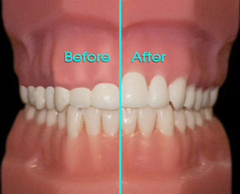
If the pockets around your teeth are too deep to clean adequately with professional cleanings and proper home care, pocket reduction surgery will be needed. Pocket reduction surgery, also known as open flap curettage, is a surgical procedure used to reduce the size and depth of the pockets that have formed between the gum tissue and the teeth. Under complete and comfortable local anesthesia the periodontist gently lifts the gum tissue away from the teeth and surrounding bone. The teeth and root surfaces are cleaned and smoothed to remove bacteria, tartar, and debris. The gum tissue is then repositioned around the teeth in a manner as to minimize the size of the pockets. Excess tissue may be trimmed away to help reduce pocket depths.
Scaling and Root Planning
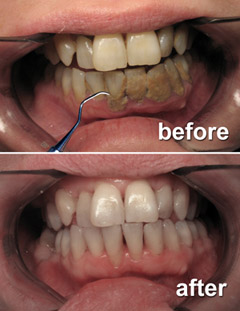
During this deep cleaning procedure plaque biofilm, calculus, and toxins against the teeth are removed from above and below the gum tissue and rough areas on the root surfaces are smoothed. By eliminating toxins and irritants the gum tissue is able to heal and the pockets begin to shrink. At times antibiotics or medicated mouth rinses are used to destroy any remaining bacteria. The goal of treatment is to remove the irritants that are causing the inflammation of the gums.This procedure can be performed painlessly with the aid of a local anesthetic.
Osseous Surgery
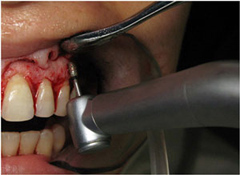
As the periodontist is cleaning the teeth and roots during the open flap curettage procedure, he or she may find that the supporting bone tissue is diseased or irregular. The periodontist will then smooth and re-shape this irregular bone to provide an optimal, healthy environment for the gum tissue to re-attach. The gums can now heal in a more uniform way and with a reduction in pocket depth.
Ridge Augmentation
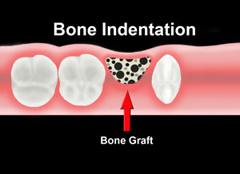
If one or more teeth are extracted, you may get an indentation in the gums and jawbone where the tooth or teeth used to be. This happens because the bone surrounding a tooth resorbs away when it is no longer holding a tooth in place. This indentation is unattractive and causes the replacement tooth to look unnatural. Ridge augmentation is a procedure that fills in this bone defect with a grafting material, re-creating the natural contour of the bone and overlying gum tissue. Ridge augmentation may also be necessary prior to placing dental implants. Dental implants are artificial roots used to replace missing teeth. Their success is dependant upon the quantity and quality of available bone, hence the need for bone grafting prior to implant placement. The artificial tooth that is then placed on top of the dental implant now looks like it is growing out of the gum as a natural tooth would. This is much more realistic looking.
Bone Grafting and Guided Tour Regeneration
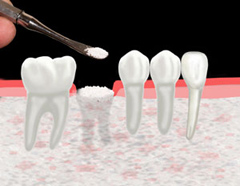
Since periodontal disease is the leading cause of bone loss in the oral cavity, bone grafting is a useful procedure to replace lost bone tissue and to stimulate natural bone growth. Bone grafts may be needed to create a stable foundation for the placement of a dental implant, to arrest the progression of periodontal disease, or to create a more esthetic smile. Bone graft materials can come from the person receiving the graft (Autogenous bone graft), from synthetic bone made in a laboratory (Allograft), or from another animal (Xenograft). Freeze dried demineralized bone (FDDMB), which has been irradiated to completely sterilize it, can also be used as a graft material. Biologic modifiers that aid in regeneration such as bone morphogenic protein, enamel matrix protein, and platelet derived growth factor are also available. All of these grafting materials are safe and have been used with success for many years. After your gum tissue has been lifted back and the disease causing bacteria has been removed from the teeth and roots, bone grafting material is used to fill the voids in the bone surrounding the teeth. Often the bone graft is also combined with tissue-stimulating proteins which help the body to regenerate bone and tissue. Tissue regenerative membranes may also be placed over the bone graft to stabilize the graft and further stimulate bone and tissue regeneration. Removing bacteria and toxins and regenerating bone and tissue helps to reduce pocket depths and repair damage caused by periodontal disease.
Soft Tissue Grafts
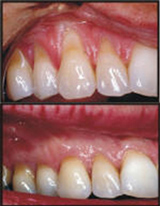
When gum tissue recedes part of the root surfaces of the teeth are exposed. This can happen because of overly aggressive tooth brushing or periodontal disease. A treatment known as a soft tissue graft can repair the defect caused by the gum recession. During this procedure a gum tissue graft, usually taken from the patient’s own mouth, is placed over the exposed areas and secured into place. Sometimes a synthetic membrane is used to cover roots where gum recession has occurred. This membrane is ultimately replaced by the body’s own natural gum tissue during the healing process. These grafting procedures are beneficial in that they help to prevent additional recession and bone loss, cover exposed roots to protect them from decay, reduce sensitivity, and improve the esthetics of your smile.
